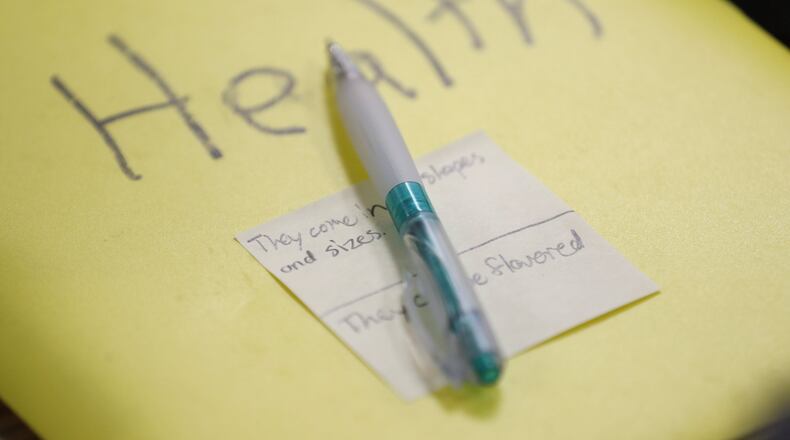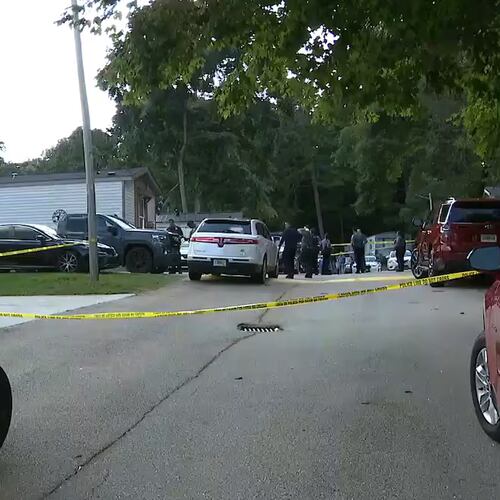For nearly two decades Les Meenan had been teaching middle school health classes pretty much the same way. He thought the efforts paid off when he saw data showing that fewer kids were smoking cigarettes. They seemed to be getting the message, whether from school or somewhere else.
Then a few years ago, a new technology and its marketing undid much of the success anti-smoking groups had seen. Vaping pens and e-cigarettes made smoking cool again. And worse than that, proponents of the devices hailed them as safe.
Educators have put vaping high on their list of concerns. Like the surgeon general and other federal, state and local officials, they worry that advertisers and manufacturers’ claims that the products aren’t marketed to children and that their habit-forming substances are harmless will cause irreparable harm to young people, or even death.
Related story: Teens new way to smoke gives parents, schools new worry
Related story: Artist Silento joins anti-vaping effort
Related story: The real cost of being a smoker in Georgia
Last week, the Georgia Department of Public Health announced the state’s first death from a vaping-linked illness. The patient, a man over age 35 who did not live in metro Atlanta, had a history of heavy nicotine vaping, but not of vaping THC, which has been linked to a majority of the mysterious lung diseases afflicting e-cigarette users. The death is one of nine confirmed cases of the illness in Georgia.
Meenan couldn’t let his students fall prey to misinformation. So he and the other physical education teachers at Webb Bridge Middle School canvassed the vape shops nearby. He wanted to witness firsthand who was frequenting these stores and what kind of information they were being given.
“At one shop I saw a lounge with some people sitting around who didn’t look like they were 18 or older,” he said. But the proprietor insisted that he checked IDs. Meenan pointed to a youngster who was clearly underage. “The guy told me he didn’t check him because he didn’t buy anything,” Meenan said.
After years of declines, teen smoking is on the rise. The number of middle and high school students using e-cigarettes rose from 2.1 million in 2017 to 3.6 million in 2018, according to the Centers for Disease Control and Prevention.
Across metro Atlanta as well as the entire country, school districts have tried a variety of methods to eliminate e-cigarette use: increased punishment, peer-generated public service announcements, adult monitors in hallways, vape-detection sensors and even taking doors off bathroom stalls.
In Gwinnett County, consequences for students caught vaping range from four days of suspension up to a disciplinary hearing that can lead to expulsion. Schools once had the option of returning confiscated vape pens, e-cigarettes and other devices to parents or guardians. Now the district has an across-the-board policy where all such products are tested for THC (the substance in marijuana that produces a high) and are destroyed.
The district keeps a record of violations of its tobacco policy, but doesn’t break them out by device. Before 2017, when vaping became more widespread, the numbers dropped from 500 violations in 2014-2015 to 306 in 2015-2017. Last year violations skyrocketed to 1,164.
“In addition to establishing disciplinary consequences for vaping at school, we are also addressing the widely held concern that many students do not understand the potential health risks associated with vaping,” said Steve Flynt, associate superintendent for school improvement and operations.
In school, students are taught about the dangers of drugs, alcohol, tobacco and other harmful substances. But when Meenan asked his eighth-graders at the Fulton County school if they’ve seen people their age vaping, all but six hands in the 18-student class went up.
Logan Wiley and Maddie Boland, members of the volleyball team, said they’d seen kids as young as sixth grade using Juuls and other vaping devices.
“I think they were mainly trying to show off,” said Maddie. “But it’s so addictive that before you know it you can’t stop.”
Logan agreed.
“It’s a big deal to get away with it — in the bathrooms or on the bus,” she said.
Both girls credit the increased information provided at school as deterrents for them.
Part of Meenan’s modified class presentation includes fast facts that students can easily remember, such as nicotine is nearly as addictive as heroine, formaldehyde (a common ingredient in vape juice) is the same stuff used to embalm dead bodies and Juuls are banned in Europe.
“A lot of kids are highly susceptible,” said Maddie. “They especially listen to older kids and do what they do.”
“I just try to stay away from that,” said Logan. “I’d rather keep to myself.”
Nearly 1 of every 20 middle school students reported in a 2018 CDC survey that they used electronic cigarettes in the past 30 days. Among high school students, it was nearly one of every five.
While nicotine, the primary addictive ingredient in all tobacco-based products, and in most e-cigarettes, has negative effects on all people, it’s especially harmful to children and adolescents, said Brian King, deputy director for research translation in CDC’s Office on Smoking and Health.
The brain keeps developing until about age 25, he said and using nicotine in adolescence can harm the parts of the brain that control attention, learning, mood and impulse control.
“Each time a new memory is created or a new skill is learned, stronger connections – or synapses – are built between brain cells. Young people’s brains build synapses faster than adult brains. Nicotine changes the way these synapses are formed,” said King. “Using nicotine in adolescence may also increase risk for future addiction to other drugs.”
Gwinnett’s Flynt said the district is continuously looking at ways to turn the tide.
The devices are easy to conceal, and some high schools have about 3,000 students. “We’ve looked at sensors for the vape smoke and the technology isn’t there yet,” said Flynt. “You pretty much have to be standing right next to it for the vapor to register.”
Several vaping pens and cartridges were confiscated from students in DeKalb County searches Sept. 27 at Lakeside, Cedar Grove and Columbia high schools, part of random sweeps that will take place throughout the year to prevent the pens, as well as weapons, from being brought to schools.
DeKalb has planned a “full-fledged campaign” on vaping, including student-collaborated anti-vaping videos and ads to be displayed on monitors throughout school district buildings, on DeKalb Schools TV, through social media and in DCSD Magazine.
“The bottom line is all these are unsafe for kids teens and young adults,” says a DeKalb student at the beginning of a 53-second video the district recently tweeted. DeKalb also plans to have a CDC representative provide training for senior staff, otherschool officials, parents and the community.
Fulton County is in its second year of a contest where students produce anti-vaping flyers and public service announces. It has also launched a series of town halls at high schools to inform parents and community stakeholders about the dangers.
With dozens of students getting sick from vaping last year, the Cherokee County School Board passed a zero-tolerance policy that went into effect in September. A student caught could face suspension, alternative school or even expulsion.
“You don’t know what’s in it. And the potential for allergic reaction is very high,” Phil Price, a member of Cherokee’s multi-agency narcotics squad told Channel 2 Action News.
“This is not a problem schools can solve by themselves,” said Flynt. “It’s an issue that needs to be on the radar of and addressed by parents, guardians and others in the community.”
Teens and vaping
Physical education teachers at Fulton County’s Webb Bridge Middle School canvassed vape shops near the campus. They gathered what they said was false information the proprietors were telling customers.
Vaping liquid is made of water. There's no water in the vape liquid. It's an oil mainly comprising chemicals such as propylene glycol, glycerin, nicotine and flavorings such as diacetyl, a chemical linked to serious lung disease, as well as heavy metals, such as nickel, tin and lead.
Using oils from reputable dealers are safe. Some of the oils were from reputable dealers but they can be purchased on the internet with no FDA approval. You have no idea what is being put in the oil because there are very few regulations.
A lady who smoked for 60 years came in and switched to a vape. The "water" in the vapor actually helped flush out her lungs and she is feeling healthier than ever. Vaping doesn't "flush out" your lungs. In fact, it does the opposite. It deposits microscopic particles into your lungs.
Vapes are used as a means to quit smoking. Most young people who vape have never tried cigarettes. Sweet flavors of vape oil attract the attention of teenagers. According to the Centers for Disease Control and Prevention, young people who use e-cigarettes may be more likely to smoke cigarettes in the future.
Only people 18 and older are allowed in the store. The teachers saw people at the store hanging out in a lounge-type area with furniture and TVs who appeared to be underage. They were visibly uncomfortable with the teachers being in there asking questions and they left.
About the Author
The Latest
Featured



